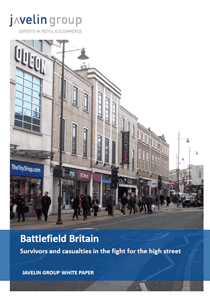67% of all shopping venues in the North East of England at risk from decline, says new White Paper from Javelin Group.
 London, 3 April 2012. Javelin Group, Europe’s leading retail and omni-channel consultants, has released a new White Paper entitled Battlefield Britain: Survivors and casualties in the fight for the UK high street.
London, 3 April 2012. Javelin Group, Europe’s leading retail and omni-channel consultants, has released a new White Paper entitled Battlefield Britain: Survivors and casualties in the fight for the UK high street.
In the report, Javelin Group identifies the town centres that are most at risk of long-term decline across Great Britain, and highlights the retailers that are most exposed to these ‘At Risk’ venues.
The report confirms a swathe of retail venues cutting across the country that are at long-term threat from the deep changes that are impacting retailing. The list of “At Risk” venues combines town centres where a significant downturn has already begun (e.g. Paisley, Stockport) together with those where a difficult future lies ahead (e.g. Nuneaton, Washington, Falkirk).
At a regional level, although the impact of multi-channel shopping is predicted to be greatest in the southern regions (where the combination of affluence, age, lifestyles and population concentration all combine to deliver the perfect environment for successful ecommerce), many of the other factors built into the Battlefield Britain rankings are less favourable with increasing distance from London and South-East.
The Battlefield Britain data confirms the North-East as the most ‘At Risk’ region in the country, with 67% of all venues assessed falling into the “At Risk” category. North-East is followed by Wales (51%) and West Midlands (44%) as the most stressed GB regions.
At the other end of the spectrum, Greater London (with only one venue (Dagenham) falling into the “At Risk” category), South-East (6% of venues) and East of England (9% of venues) provide a significantly more encouraging long-term outlook for store-based retail in town centre venues.
Javelin Group has assessed the store portfolios of over 200 leading UK multiple retailers (each with more than 50 stores across the town centres assessed) and identified those with the most significant bias in their chain distribution towards ‘At Risk’ venues.
Clearly, many of these retailers have formats which are very well adapted to, and are even benefiting from, challenging local retail dynamics (e.g. Brighthouse, Home Bargains, Lidl). Indeed, the list of retailers with high exposure to “At Risk” venues is dominated by value-oriented formats. However, the question remains whether the “At Risk” venues can continue to attract sufficient shopper numbers to the high street to provide an attractive long-term opportunity for even these well-adapted formats.
For others (e.g. Evans, Card Factory and Argos) a more significant restructuring of the portfolio (or the role the stores play) may be required as the long-tem shift in retail geography occurs.
Leading retailers which appear to have their store networks focussed on the most stable retail venues include: Pret, Karen Millen, Hobbs and Office.
Battlefield Britain concludes that whilst the future will be about fewer, bigger, better stores and shopping environments for UK consumers, the transition will be painful for towns which do not have the attributes necessary to maintain a vibrant commercial hub. But whilst Battlefield Britainpresents a challenging, but not a pre-determined, view of the future for UK town centres: rapid action now can change local outcomes.
The challenging view of the future may be inevitable at the national level, but local outcomes will vary. The private and the public sectors both have the capacity to influence change, whilst the factors contributing to the Battlefield Britain score for each venue assessed will inevitably overlook some local factors (such as quality of environment, heritage, community, change in the competitive environment) which will also have a strong influence on how the future turns out.
Commenting on Battlefield Britain, Miles Dunnett, head of asset management at Grosvenor Liverpool Fund, said: “Javelin Group’s report brings significant additional insight to the debate about the future of our towns and cities. Not only does it highlight the real issues facing the UK’s high streets, but the key regional differences that should inform the strategic direction for both the public and private sectors; for local authorities, landlords and retailers alike. More than that, the report focuses on the importance of these three stakeholders working together to create and implement plans that reverse the fortunes of the places that will be hardest hit. There is also a lot that can be learnt from those locations that are already in a stronger, more robust position. The insight that exists must be captured and shared and the publication of this report will benefit that process.”
Bob Mogford, director of Investment Management at PRUPIM, said: “The nation’s high streets are clearly facing forces for change at an arguably unprecedented rate in modern times and Javelin Group has used its extensive range of research tools to come up with an insightful geographic perspective on how this could play out over the next few years.”
Robin Bevan, director of Javelin Group said: “Our White Paper is intended to be a helpful guide for retailers and brands to understand where their store portfolios are most at threat and what actions should be taken. Similarly, town centre managers and local authorities will see in this report which venues need the most urgent attention to adapt to the dramatic shifts in shopping habits that are taking place today.”
In the press
- This is Somerset: High street risk rating bolsters team’s resolve
- Yeovil Express: Report suggests Chard town centre ‘at risk’
- Chelmsford Weekly News: Colchester’s High Street ranked in country’s top 30
- View Online: Chard: Town needs more footfall
- East Anglian Daily Times: Bury St Edmunds: Shopping area is in top ten for mid-sized towns
- Regeneration & Renewal: Government’s approach to high streets…
For more information, please contact marketing@javelingroup.com.